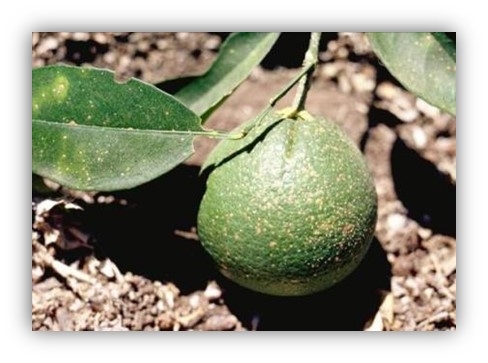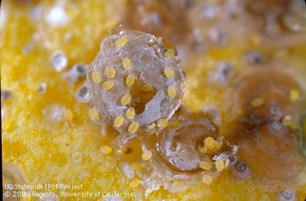California red scale is a key pest of citrus in California. Its life cycle starts as crawlers produced by overwintering females from the past season. Crawlers move and find a suitable place to start feeding. Once they have settled they do not move. Traditionally growers have managed scale populations using insecticides. Insecticide applications give the best results when the population is at the most susceptible stage and is uniform.


California red scale: crawlers emerging from female (left), fruit infested with CRS (right)
Pheromone trap cards (catch males) and degree days accumulation (predict the next life event - crawlers, male flight) is the most used method for monitoring red scale population activity in the San Joaquin valley. For the last several month's Entomology research team at Lindcove Research and Extension Center has been monitoring degree days in Kern, Tulare, Fresno, and Madera counties. The latest update as of July 07, 2022, shows that degree day accumulation in all these counties has exceeded 1650, degree days, a threshold for the second-generation crawler emergence. Pheromone traps are used to monitor male flight activity. Following the biofix (first male flight), degree days are used to predict when the crawler emergence or next-generation flight takes place. This helps growers make timely spray applications to target the most susceptible life stage. Please visit Degree Days for county-wise information. Degree days are taken from CIMIS weather stations in different counties.
When to spray insecticides?
- First and second generations have a more synchronized population. The current population in the SJV is the second generation.
- Crawlers and first instars are the most susceptible stage (thin wax layer).
Degree days as of July 07, 2022: Degree days are heat units accumulated above the developmental threshold, 53°F, for California red scale.
Kern County: 1939 DD. Second-generation crawlers started emerging at 1650 DD. Make spray application without delay! Crawlers and white caps (first instar) are the most insecticide-susceptible life stage.
Tulare County: 1695 DD. Second-generation crawlers are out. Plan to make an application in the coming week. Crawlers and white caps are the most insecticide-susceptible life stage.
Fresno County: 1764 DD. Second-generation crawlers are out. Plan insecticide application without delay. Crawlers and white caps are the most insecticide-susceptible life stage.
Madera County: 1715 DD. Second-generation crawlers are out this week. Plan insecticide applications. Crawlers and white caps (first instar) are the most insecticide susceptible life stage.
What to apply?
UCIPM guidelines have a list of recommended products to use for managing California red scale populations. UCIPM guidelines have been recently updated to include updated information. Please check it out!
The goal is to maintain CRS at a level that does not result in more than 5% fruit infested at harvest (>10 scales). Pheromone cards may not be a good indicator of field population based on your pest management choices.
- Aphytis release blocks – pheromone cards overestimate scale numbers, as Aphytis attacks third instar females.
- Insect growth regulator/mating disruption – pheromone cards underestimate scale numbers as these treatments affect males more than they affect females. For determining if mating disruption is effective – use a threshold of 50 scales per flight.
- Movento/Admire – not a reliable predictor, especially if you have a history of scale infestation as these products do not kill scale on wood or scale.
Drop a comment below about your experience with CRS management in 2022!
Attached Images:

